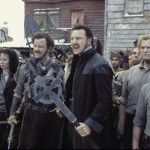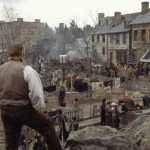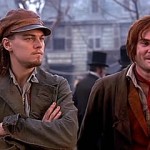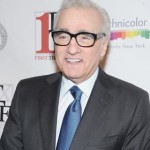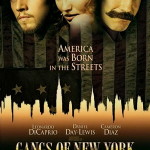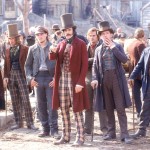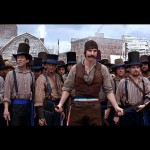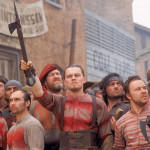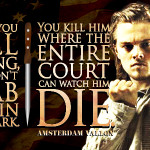This is the fourth Scorcese review I’ve written in recent weeks, following The King of Comedy, Goodfellas and The Wolf of Wall Street, with another (The Departed) to follow; the more I write the greater the pattern I can see. It’s fair to say that I have something of a love-hate relationship with the director, especially with his love affair with Leo diCaprio, a casting that worked remarkably well in Wolf but has detracted from other movies.
A little background from Wikipedia just to set the scene:
In 1999 Scorsese also produced a documentary on Italian filmmakers titled Il Mio Viaggio in Italia, also known as My Voyage to Italy. The documentary foreshadowed the director’s next project, the epic Gangs of New York (2002), influenced by (amongst many others) major Italian directors such as Luchino Visconti and filmed in its entirety at Rome’s famous Cinecittà film studios.
With a production budget said to be in excess of $100 million, Gangs of New York was Scorsese’s biggest and arguably most mainstream venture to date. Like The Age of Innocence, it was set in 19th-century New York, although focusing on the other end of the social scale (and like that film, also starring Daniel Day-Lewis). The film also marked the first collaboration between Scorsese and actor Leonardo DiCaprio, who since then has become a fixture in later Scorsese films.
In case you needed reminding, this is the director of timeless classics like Mean Streets, Taxi Driver and Raging Bull – all of which would easily sit happily among the all-time greatest, but I disliked The Aviator and especially the performance of Scorcese’s favourite leading man with a passion, nor was I impressed by Shutter Island, nor especially by his De Niro vehicle (his previous favourite leading man) remake of Cape Fear, nor Casino.
The movies I reviewed are all exceptionally skilled, though maybe some would find them patchy and surprisingly uninvolving. Maybe the same is also true of his sprawling epic Gangs of New York. Make no mistake, this is a vast and impressive enterprise, requiring no little orchestration. It works best with the huge set-piece crowd scenes and appallingly bloody battles, and least well with some of the more intimate scenes. Ironic then that despite his reputation for blood-and-guts epics, Scorcese showed a remarkable delicacy of touch in bringing a period piece to the screen in the form of The Age of Innocence (which I saw in Hong Kong.) Maybe he should aim more for shorter movies with greater subtlety and analysis of human nature, and use for those scenes actors capable of greater breadth of emotional intensity than DiCaprio?
Sustaining a 3-hour movie is by no means a simple task, and light and shade created to break up the very detailed narrative structure leaves the viewer feeling that the pacing is awkward, attention is lost along the way and there is little scope to gain the emotional involvement that worked so well in Innocence. This work is very definitely patchy, and for all the skill in the detail is marginally less than the sum of its parts. Maybe no surprise then that for all its nominations, the movie won no major gongs:
Originally filmed for a release in the winter of 2001 (to qualify for Academy Award nominations), Scorsese delayed the final production of the film until after the beginning of 2002; the studio consequently delayed the film for nearly a year until its release in the Oscar season of late 2002. Gangs of New York earned Scorsese his first Golden Globe for Best Director. In February 2003, Gangs of New York received 10 Academy Award nominations, including Best Picture, Best Director, and Best Actor for Daniel Day-Lewis, however it did not win in any category.
Getting back to basics, the first thing I noticed when watching the film for the second time is the extensive cast of fine British and Irish character actors. The Irish are perhaps more understandable, given that the gangs include Irish expats arriving on American shores in the 1840s, but the reason for casting Brits like Jim Broadbent, Daniel Day Lewis (who is dual nationality British and Irish), John Sessions, Alec McCowen, David Hemmings, Eddie Marsan, Gary Lewis, Stephen Graham, Roger Ashton-Griffiths, Cara Seymour, Peter-Hugo Daly and Michael Byrne (plus the Irish Liam Neeson and Brendan Gleeson) in what is essentially a tale of turf wars for a small section of Manhattan Island is clearly no accident and is arguably the most successful aspect of the production.
Indeed, but for DiCaprio (putting on his archetypal frown throughout) and Cameron Diaz there are no native Americans (as opposed to Native Americans) in leading roles, which is ironic given that Day Lewis leads the “Natives” gang (who seem related to the Bowery Boys) putting the immigrant hordes in their place.
Perhaps the best answer is that (a) Americans don’t like playing baddies, and there are many characters in this movie that are broadly unsympathetic and with few if any redeeming qualities – though not really the characters played by Americans, and (b) Scorcese deemed the technique of British actors, many of whom learned their trade on the stage before graduating to film and less from the Method school, more appropriate to the movie.
Having said that, Day Lewis is very much of the Method, but (a) certainly applies here; he approaches the role of Bill “The Butcher” Cutting, the man who “owns” the Five Points and is not afraid to flout the law by murdering in cold blood and in public anyone who questions his authority, with zestful glee. Playing villains is so much more enjoyable than playing heroes, which has probably contributed to the fact that most movies coming out of the Hollywood machine nowadays depict “flawed heroes” rather than halo-polishing saints.
The trouble was less on-set than off. Also from Wikipedia:
The production was highly troubled with many rumors referring to the director’s conflict with Miramax boss Harvey Weinstein. Despite denials of artistic compromise, Gangs of New York revealed itself to be the director’s most conventional film: standard film tropes that the director had traditionally avoided, such as characters existing purely for exposition purposes and explanatory flashbacks, here surfaced in abundance.
The final cut of the movie ran to 168 minutes, while the director’s original cut was over 180 minutes in length. The film still received generally positive reviews with the review tallying website Rotten Tomatoes reporting that 75% of the reviews they tallied for the film were positive and summarizing the critics by saying “Though flawed, the sprawling, messy Gangs of New York is redeemed by impressive production design and Day-Lewis’s electrifying performance.”
Nonetheless, the themes central to the film were consistent with the director’s established concerns: New York, violence as culturally endemic, and sub-cultural divisions down ethnic lines.
Another question might be asked of Scorcese’s choice in selecting a musical score to unite the various components of the movie and the characters, which to my ears was not the greatest of successes.
The original score composed by regular Scorsese collaborator Elmer Bernstein was rejected at a late stage for a score by Howard Shore and mainstream rock artists U2 and Peter Gabriel.
Maybe with the benefit of hindsight a number of mistakes were made, and that a shorter better-edited movie would have had a greater impact. I don’t doubt Scorcese’s skill but his judgement is sometimes wayward, and movies with a core of wonderful talent do tend to become bloated and unfocused, a criticism similar to the later movies of Tarantino, for example. A 2hr 20min movie would have been sharper and delivered a far more effective viewing experience.
Where it succeeds, it succeeds brilliantly, notably the look and feel in depicting the battle for New York’s lawless heart, the props, the costumes, even the accents – as authentic as you could ever hope to find. The acting from the British and Irish side of the fence is uniformly excellent, though this is yet another DiCaprio that fails to convince me. That aside, concentrate on the virtues and you will have much to enjoy.



